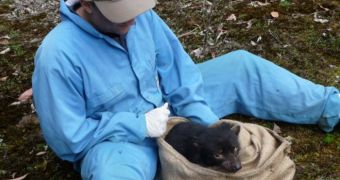Investigators funded by the US National Science Foundation (NSF) have determined in a new study that Tasmanian devils may soon go extinct as a species. The reason for this is the uncontrolled spread of devil facial tumor disease (DFTD), which appeared some years ago. It has been slowly decimating devil populations throughout Tasmania ever since.
One of the reasons why the condition spreads so fast is that the devils are highly aggressive creatures that tend to bite each other even while feeding. Since this disease is transmitted primarily through biting, it follows that any encounter between these creatures will lead to more infections.
Unless researchers are able to come up with a cure for DFTD, Tasmanian devils are likely to go extinct altogether, and soon, say investigators from the Washington State University (WSU), in the US.
These creatures, known scientifically as Sarcophilus harrisii, became the largest marsupial carnivores in the world in 1936, when the Tasmanian tiger (Thylacinus cynocephalus) went extinct. Now, it would appear that this “honor” may be passed on yet again.
Unlike Tasmanian devils, Thylacines were found throughout Australia, Tasmania and New Guinea, but this diversity could not help them when their species disappeared. Scientists say that Sarcophilus can avoid the same fate if medical solutions are found in time.
“If a way isn't found to stop devil facial tumor disease […], models predict that Tasmanian devils could be extinct in as few as ten years,” explains WSU disease ecologist, Andrew Storfer. He adds that DTFD is a type of parasitic cancer that is 100 percent lethal.
Studying it could offer more insight into how cancer affects other species, including humans. If the Tasmanian devils disappear, any potential insights into cancer evolution and traits in animals will disappear with them.
The NSF-funded study “provides an excellent test-bed for understanding the spread of infectious diseases. The results may help us control the spread of seasonal flu in people, West Nile virus in birds and white-nose syndrome in bats, among many other diseases,” says the director of the NSF Ecology and Evolution of Infectious Diseases (EEID) Program, Sam Scheiner.

 14 DAY TRIAL //
14 DAY TRIAL //